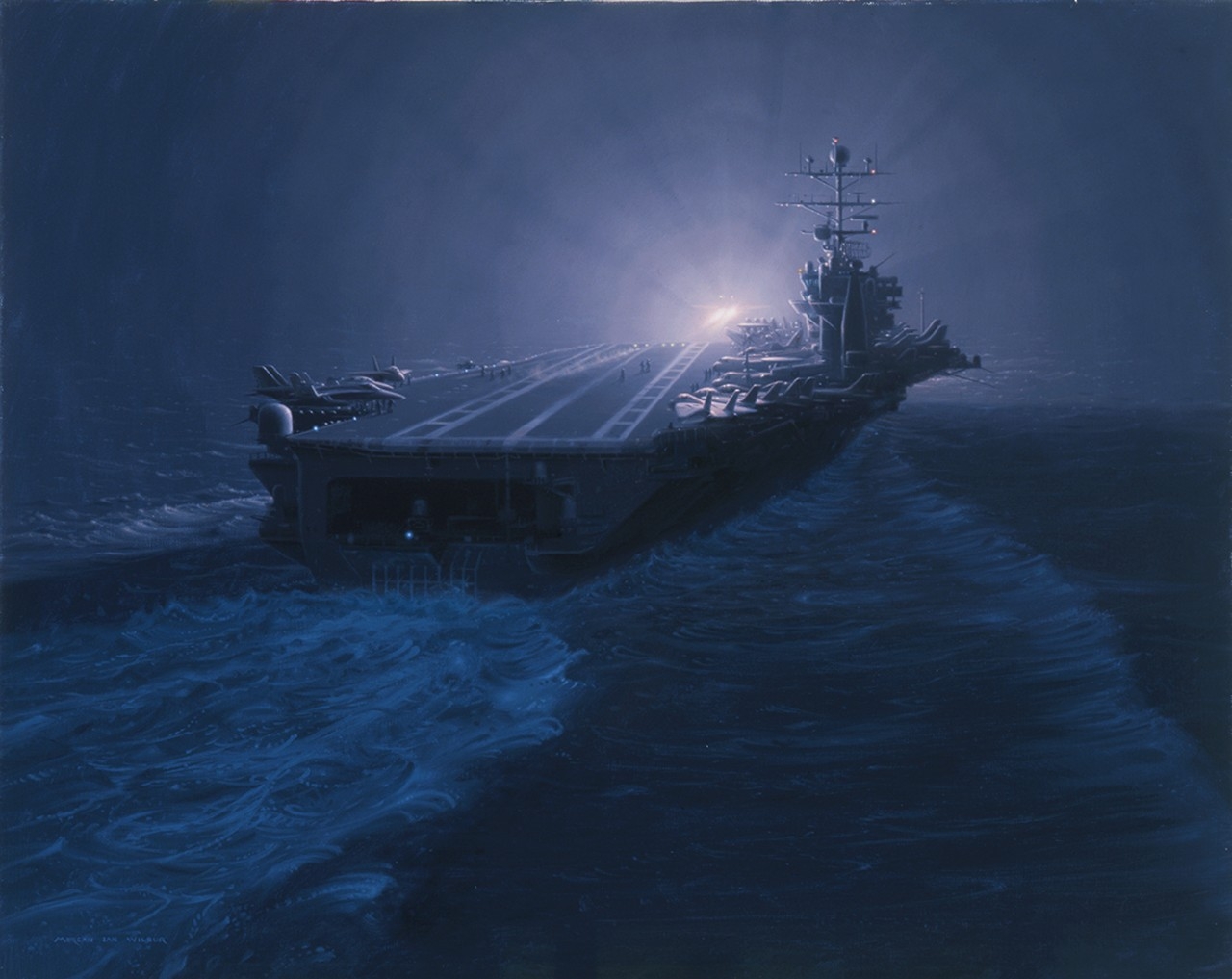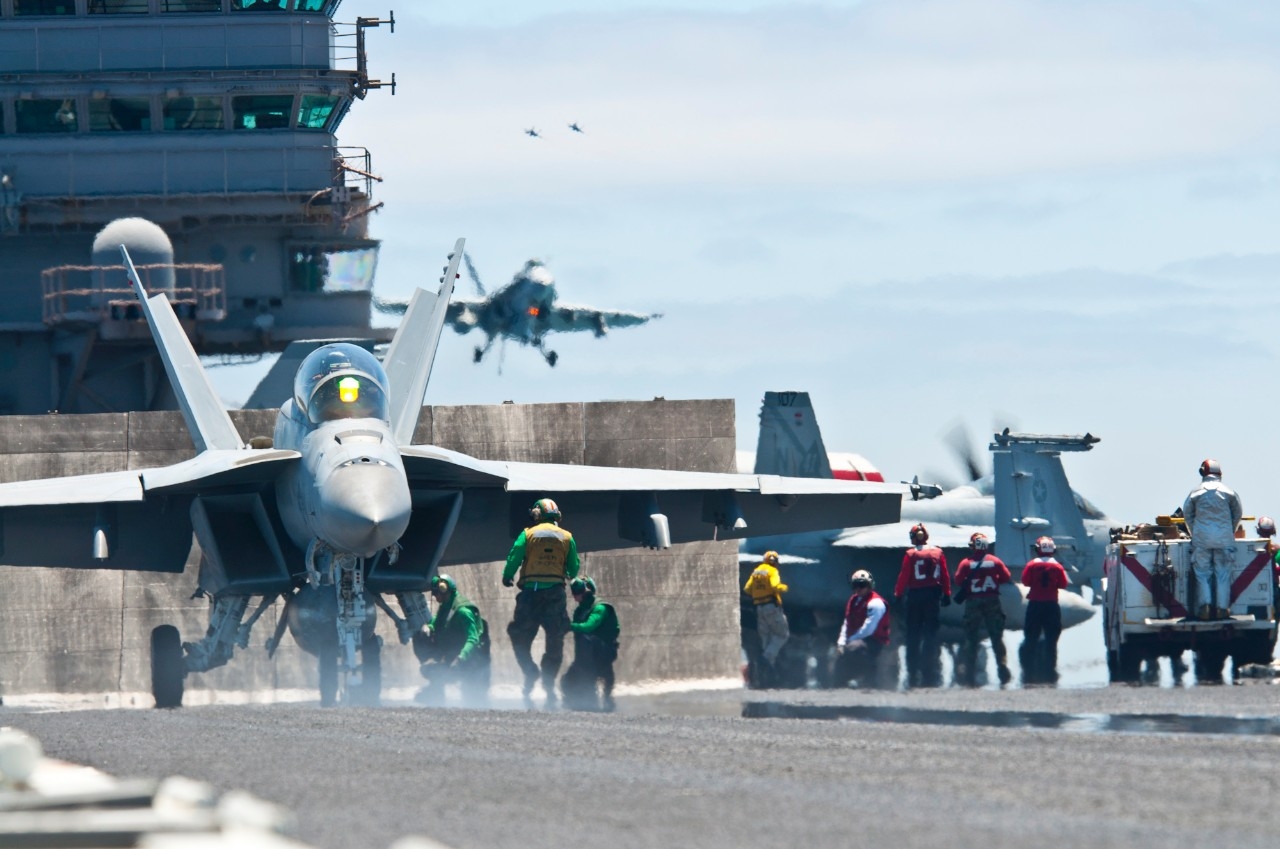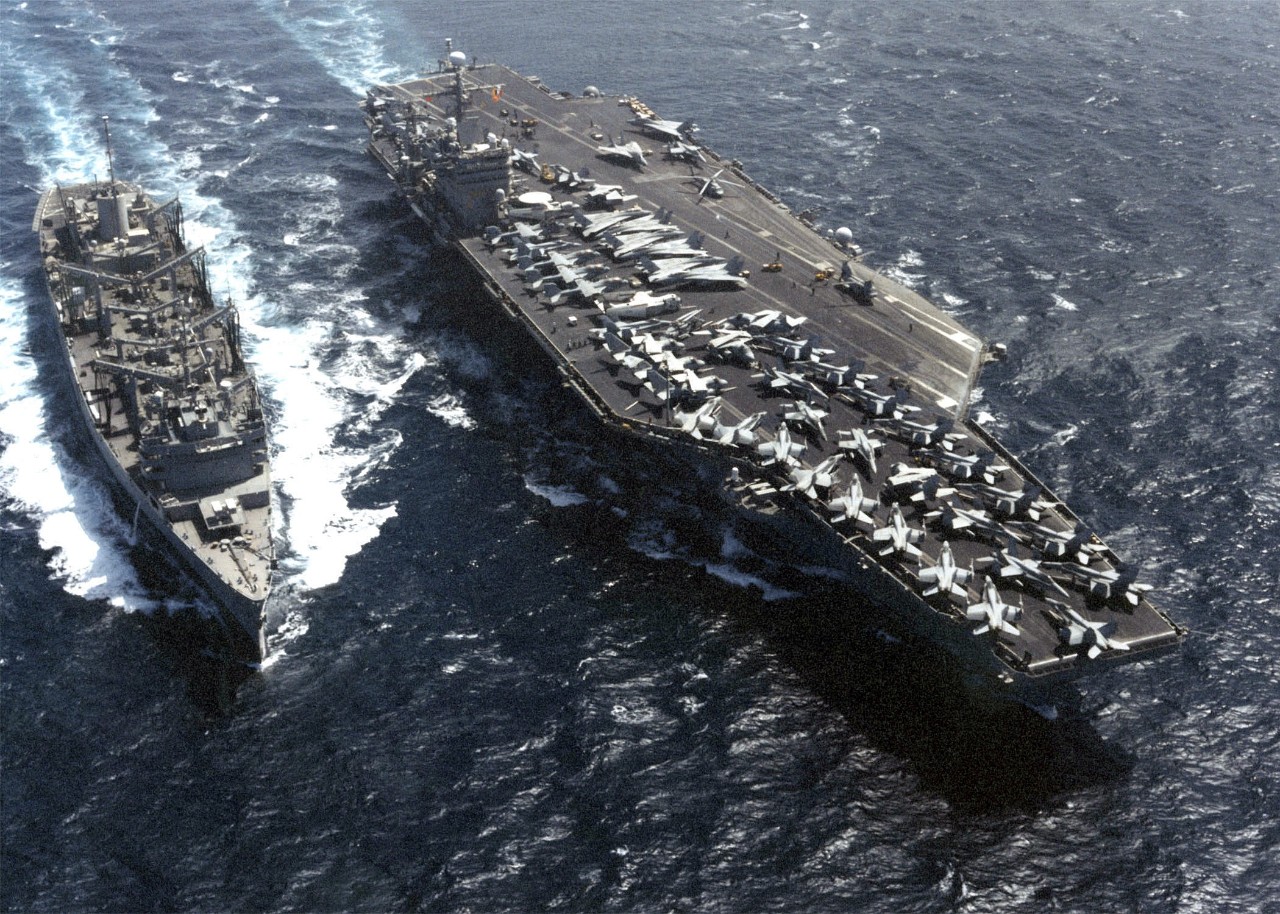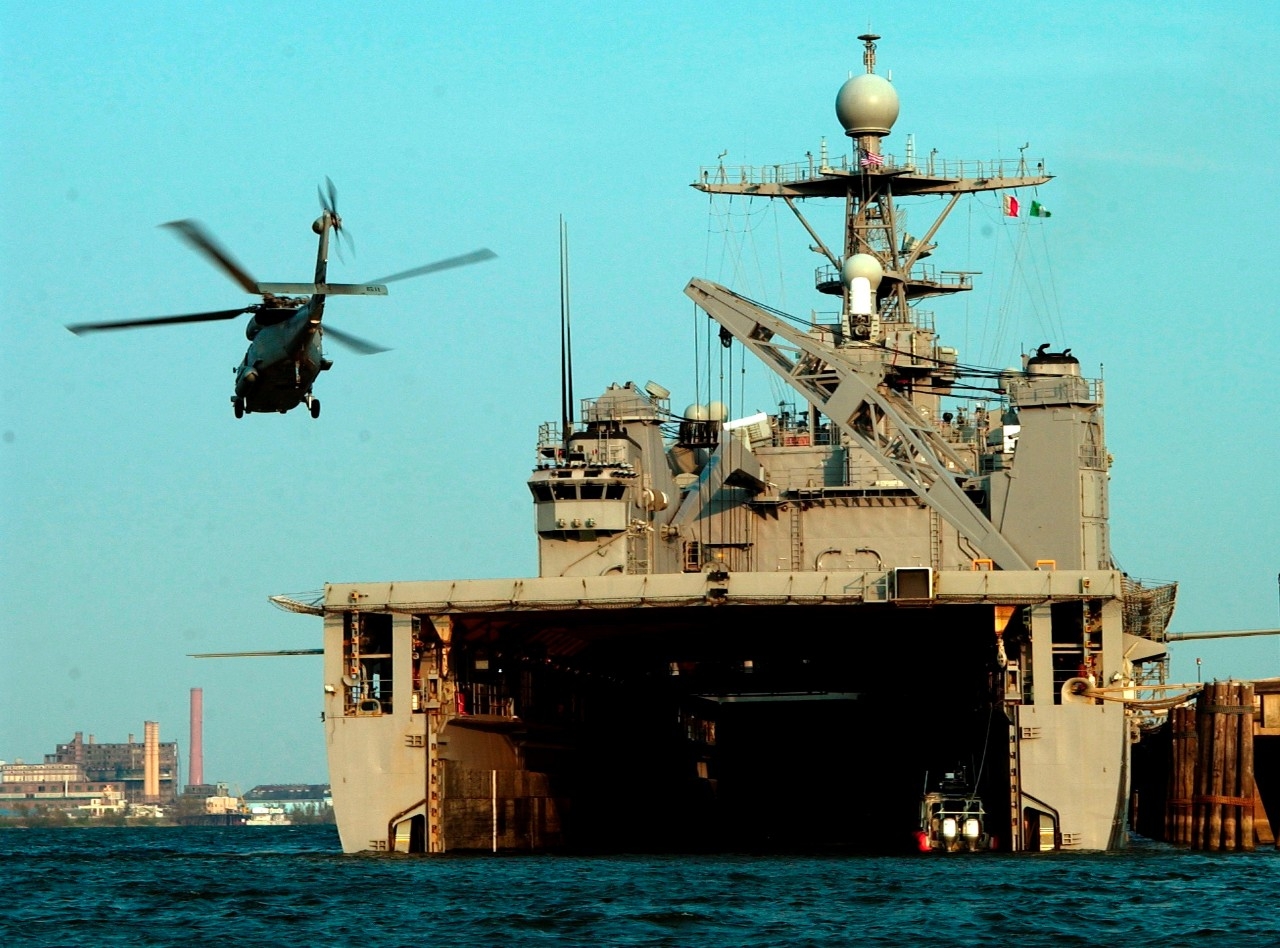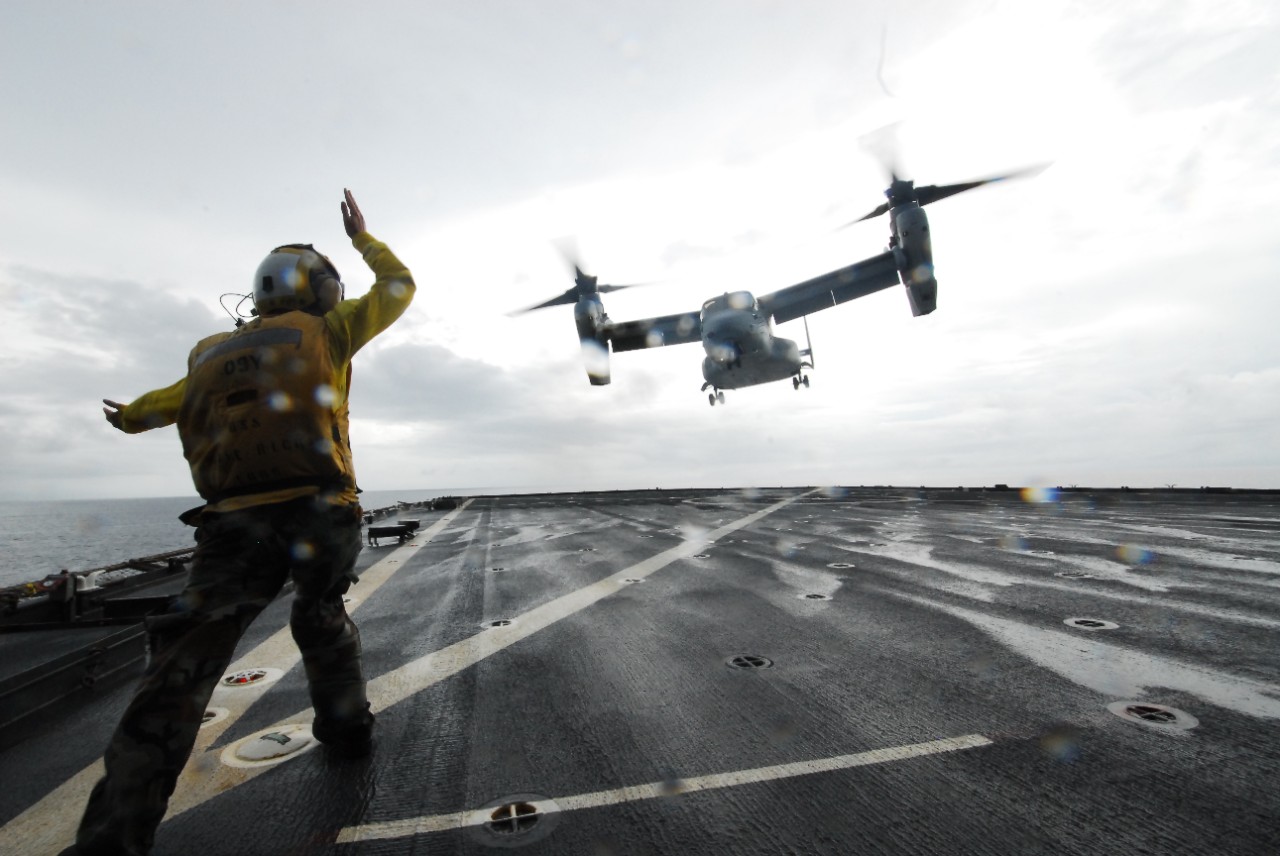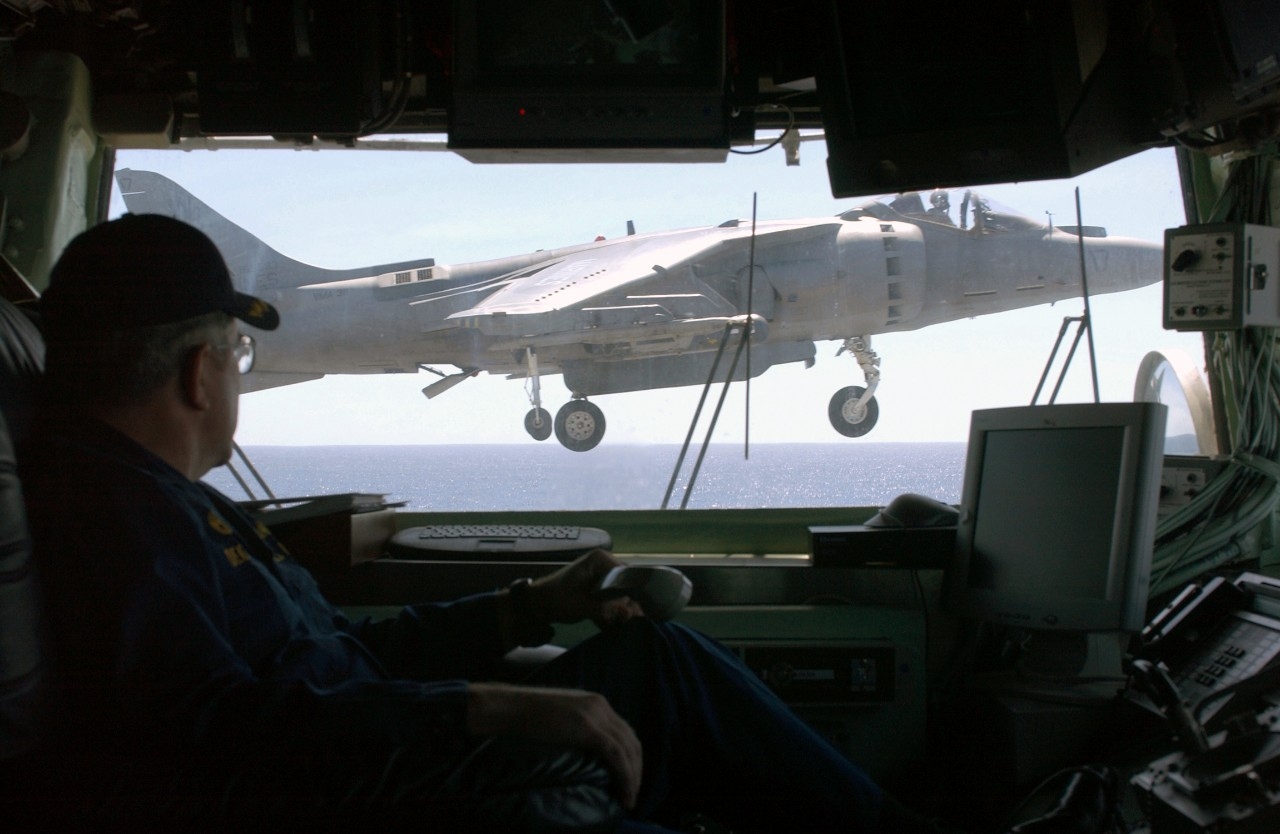2000–2010
Dawn of the Twenty-first Century
(2000–2010)
Naval aviation entered the third millennium responding to crises around the world while developing the weapons to project American power. Sailors and Marines deployed to challenge dictators who sought weapons of mass destruction, rescued victims of natural disasters, and turned up the heat in the war on drugs. On 11 September 2001, terrorists owing allegiance to al-Qaeda attacked the United States, aided and abetted by the Islamic fundamentalist Taliban who ruled most of Afghanistan. The refusal of the Taliban to extradite al-Qaeda operatives prompted the United States to invade Afghanistan.
Naval aviation carried out missions over dynamic battlefields in Afghanistan and Iraq. Aircrew supported rapidly developing operations when the need for time-sensitive strikes led to the reception of target assignments while already airborne.
The fleet also tackled global security missions with aerial surveillance and sea control sorties to ensure the uninterrupted flow of oil, provided intelligence and situational awareness to theater commanders, participated in maritime interceptions, evacuated casualties from battlefields and the high seas, and hunted for drug smugglers to reduce the flow of contraband onto America’s streets. Space shuttle missions launched with predominately Navy crews, and the Coast Guard celebrated its 217th birthday by announcing its rescue of more than a million lives since its inception.
Naval aviation organizational and operational methods evolved to reflect changing missions. Carrier battle groups were restructured and redesignated as carrier strike groups and fell under numbered fleet commanders for operational and administrative control. Fighter squadrons became strike-fighter squadrons during the transition from F-14 Tomcats to F/A-18 Hornets and Super Hornets. Sea control squadrons dropped from the roster as submarine hunting missions shifted to helicopters, and wings and squadrons underwent reorganization to reflect the transition from five helicopter models to two.
A number of new aircraft types joined the fleet along with smaller precision-guided munitions being added to the inventory. Plus, a new dimension and harbinger of future naval aviation — unmanned aerial systems — was integrated into operations.
*****
13 March 2000—The Navy celebrated the opening of the first permanent hangar designed and built specifically for unmanned aerial vehicles at the Webster Field annex, NAS Patuxent River, Maryland. The $2.4 million project proved crucial to VC-6 Detachment A because the Sailors had hitherto operated and maintained RQ-2A Pioneers at the mercy of the elements.
16 July 2000—F/A-18Fs made their worldwide debut when two of the Super Hornets from VFA-122 flew nonstop from NAS Patuxent River, Maryland, to the international air show at Farnborough, England.
An F/A-18F Super Hornet of VFA-41 moves onto a catapult to launch while John C. Stennis (CV-74) completes sustainment exercises in southern Californian waters, 6 July 2012. Another jet approaches to land and two more circle during the busy flight operations. (Mass Communication Specialist Seaman Nolan Kahn, US Navy photograph 120706-N-NK714-210)
20 January 2001—Naval aviator Donald H. Rumsfeld was sworn in as the 21st Secretary of Defense.
16 February 2001—Since Operation Desert Fox in 1998, the Iraqis had launched more than 60 surface-to-air missiles and fired antiaircraft guns more than 1,000 times at coalition aircraft. Initially, Iraqi gunners learned to briefly radiate their radars, then shut down and run to escape allied AGM-88 HARMs (High-speed Anti-Radiation Missiles). Iraqi dictator Saddam Hussein later linked the air defense network with fiber optic cabling so that radars from around Baghdad—outside the no-fly zones—could radiate and send targeting data to remote antiaircraft sites. The Americans and British, therefore, attacked military targets with the largest strikes since Desert Fox. F/A-18Cs from VFA-37 and -105 and VMFA-312, and EA-6B Prowlers from VAQ-130, embarked on board Harry S. Truman (CVN-75), and Air Force F-15E Strike Eagles and British GR.1 Tornados, struck five Iraqi radar, and command, control, and communication nodes outside Baghdad with a variety of ordnance including Hornet-launched AGM-154A JSOW (Joint Standoff Weapons).
7 October 2001—Enterprise (CVN-65) and Carl Vinson (CVN-70) spearheaded the first coalition strikes against al-Qaeda terrorists and the Taliban in Afghanistan in response to the Sept. 11, 2001, attacks on New York City, the Pentagon, and the failed attack that led to American Airlines Flight 93 crashing in a field in Pennsylvania. The terrorists' attacks killed an estimated 2,977 people. In response, Secretary of Defense Donald H. Rumsfeld announced the designation of America’s war on terrorism as Operation Enduring Freedom.
16 January 2003—Space shuttle Columbia, on mission STS107, launched from John F. Kennedy Space Center, Florida. At about 9 a.m. on 1 February, the shuttle broke apart during reentry over Texas killing all seven crewmembers including naval aviation veterans Capts. David M. Brown and Laurel B. S. Clark and Cmdr. William C. McCool. Investigators concluded that a thermal protection system breach on the left wing leading edge allowed superheated air to penetrate during reentry and progressively melt the wing’s aluminum structure, which weakened it until aerodynamic forces caused its failure and loss of control.
19 March 2003—The coalition launched Operation Iraqi Freedom. From June 2002 to this date, allied aircraft had struck nearly 400 Iraqi military targets. During the first 19 days of March, the pace of operations increased and aircraft flew 4,000 strike and support sorties against Iraqi radar, antiaircraft guns, and fiber-optic links to suppress enemy air defenses in preparation for the invasion of Iraq.
29 August 2005—Hurricane Katrina made landfall along the coast of the Gulf of Mexico. A catastrophic storm surge inundated the levees along the Mississippi River and the rising waters flooded 80 percent of New Orleans, Louisiana. Six E-2C Hawkeyes from VAW-77, -121, and -126 monitored airspace and directed rescue aircraft. On 30 August, amphibious assault ship Bataan (LHD-5) arrived and augmented two embarked MH-60S Seahawks of HSC-28 with four MH-53E Sea Stallions from HM-15. Meanwhile, amphibious assault ship Iwo Jima (LHD-7) moored at New Orleans and became a hub for helicopters as Headquarters, Joint Task Force Katrina. On 1 September, Harry S. Truman (CVN-75) arrived with elements of 13 helicopter squadrons embarked. Additional naval aviation reinforcements included MH-60s of HSL-43, -47, and -49, and HC-11, two CH-46E Sea Knights and six CH-53E Super Stallions from six Marine squadrons at MCAS New River, North Carolina, four Super Stallions from HMH-772, and VR-57 and -58. Seventy-six Coast Guard and Coast Guard Auxiliary aircraft rescued 12,535 people during 1,817 sorties. Altogether, more than 5,000 Coast Guardsmen saved 33,545 lives. More than 70 fixed-wing aircraft and 350 helicopters from all the services responded.
8 October 2005—A 7.6 magnitude earthquake near the Indo-Pakistani border killed more than 73,000 people and rendered nearly three million homeless. Commander Tarawa (LHA-1) Expeditionary Strike Group Rear Adm. Michael A. LeFever coordinated the operations of the Disaster Assistance Center at Islamabad, Pakistan. Through 13 February, two HM-15 MH-53E Sea Dragons, two HSC-26 MH-60S Seahawks, a VQ-2 EP-3E Aries II detachment, a VR-56 C-9B Skytrain, a VR-64 C-130T Hercules, and Army, Air Force, and allied aircraft flew more than 4,000 missions, delivered over 11,000 tons of supplies, and transported more than 18,000 people.
3 March 2006—VMM-263 at MCAS New River, North Carolina, was activated as the first operational MV-22B Osprey squadron.
22 September 2006—After 36 years of service, the Navy retired the F-14 Tomcat in a final flight ceremony at NAS Oceana, Virginia. On 4 October, an F-14D of VF-31, BuNo 164603, completed the last Tomcat flight from Oceana to Republic Airport, Farmingdale, New York. The jet spent just over a year on display at the American Airpower Museum at the airport, and was then assigned for display at Northrop Grumman, Bethpage, New York.
15 December 2006—The first flight of an F-35A Lightning II took place at Lockheed Martin, Fort Worth, Texas.
12 January 2010—A magnitude 7.3 earthquake devastated Port-au-Prince, Haiti, killing an estimated 230,000 people. The United States initiated Operation Unified Response— humanitarian aid to victims. At the operation’s peak, 23 Navy ships participated, including Carl Vinson (CVN-70) with Carrier Air Wing 17 embarked; amphibious assault ships Bataan (LHD-5) and Nassau (LHA-4); dock landing ships Ashland (LSD-48), Carter Hall (LSD-50), Fort McHenry (LSD-43), and Gunston Hall (LSD-44); amphibious transport dock Mesa Verde (LPD-19), with the 22d and 24th Marine Expeditionary Units embarked; and 10 Coast Guard ships. A total of 264 U.S. fixed-wing aircraft took part including C-2A Greyhounds of VRC-40; C-40A Clippers; C-130 Hercules; E-2C Hawkeyes of VAW-125; and P-3C Orions of VP-26 and -62; along with 57 helicopters and tiltrotor aircraft including USCG HH-60J Jayhawks; MH-53E Sea Dragons of HM-14 and -15; SH-60B Seahawks of HSL-46 and -60; MH-60Ss of HSC-9, -22, -26, and -28; MV-22B Ospreys of VMM-162; and Marine CH-46E Sea Knights and UH-1N Iroquois. The Air Force diverted an RQ-4A en route to Afghanistan and operated the Global Hawk on several reconnaissance missions over Haiti from NAS Patuxent River, Maryland. Airlifters of all the services and international aid agencies staged through NAS Jacksonville, Florida. Carl Vinson departed on 1 February, and by 24 March these vessels largely sailed from Haitian waters, although relief efforts continued into the summer.
Additional Resources
The U.S. Navy in the World (2001-2010)
V-22 Osprey Tilt-Rotor Aircraft (Congressional Research Service Report for Congress)
Unmanned Vehicles for U.S. Naval Forces: Background and Issues for Congress

